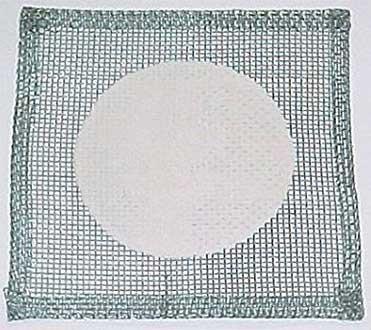Purpose
This safety alert is to warn of asbestos in Bunsen burner gauze mats with ceramic pads that have been imported into Australia Gauze mats without a ceramic centre (i.e. they are all metal) are outside the scope of this alert.
Product description
The circular ceramic material in the centre of the gauzes is used for its heat-resistant properties. The gauzes with ceramic centre are conventionally used with tripods and Bunsen burners as shown in Figures 1 and 2.
Gauze mat with ceramic centre

Gauze mat sitting on tripod over a Bunsen burner

These gauze mats are not branded making visual identification of mats potential containing asbestos impossible.
Background
Tremolite asbestos has been identified in the ceramic centre of some Bunsen burner gauze mats in New Zealand and the United Kingdom. Preliminary testing has indicated that this may be an issue in imported gauze mats imported into Australia and further testing is underway to confirm this.
As these gauze mats have been imported and supplied within Australia, the Rapid Response Protocol (RRP) has been initiated. More information on the RRP is available at the Commonwealth Asbestos Safety and Eradication Agency website.
Risk
Preliminary analysis of the ceramic material from some gauze mats identified fibres of tremolite asbestos. The fibres are bonded to the ceramic material. Any risk from asbestos depends on the extent of asbestos fibre release and inhalation of these fibres.
The risk of asbestos exposure from the ceramic material will generally be extremely low when the mats are used under normal conditions, because:
- the material is predominantly non-asbestos
- there is very limited physical contact with the material during use (e.g. items are placed on top)
- any contact is light and momentary
- the ceramic material is hard and fibres are bonded to the ceramic material.
If the ceramic material becomes soft and crumbly, or is damaged, the negligible risk of exposure may increase.
Steps have been taken by work health and safety regulators to prevent further supply by known suppliers.
Action required
Under Queensland work health and safety laws it is unlawful for a PCBU to use a gauze mat containing asbestos.
1. Isolate current stock
It is recommended that users adopt a precautionary approach as the gauze mats containing asbestos cannot be easily identified visually, from those that do not. Users should not handle, use or move their current stock of gauze mats until they have checked with their supplier to confirm if they contain asbestos.
2. Obtain test data or assume asbestos is present
If the supplier cannot provide analysis information that meets the standard outlined further on in this alert under the section ‘testing requirements’, the user should assume the gauze mats contain asbestos and dispose of them as outlined below. The relatively low cost of replacing the gauze mats will far outweigh the cost of having the gauze mats tested by the user.
3. Safely dispose of gauze mats containing or assumed to contain asbestos.
The work to dispose of the gauze mats and waste items is a low-risk activity, but still needs precautions and controls in line with legal requirements. The work should only be done by people who are confident that they can follow the safety procedure and have access to the right equipment. Alternatively, organisations may choose to engage a licensed asbestos removalist.
As the asbestos fibres are bonded to the ceramic material, personal protective equipment (PPE) is not usually required when handling the gauze mats. Users may wish to adopt a precautionary approach and use of PPE and personal protective clothing.
When gauze mats with no asbestos are stored directly alongside mats that contain asbestos, they should be treated as contaminated waste. Other equipment (such as clay triangles, Bunsen burners etc.) which have been stored with contaminated gauze mats, and the storage area, should be wiped clean with a wet wipe if there is any visible dust present. The cloth should be disposed of as contaminated waste.
The gauze mats should be wetted using a hand held spray bottle containing water with a small quantity of detergent (e.g. dish washing liquid or PVA glue) and handled carefully to prevent any further damage. The gauze mats should be contained for disposal by placing them in either:
- a rigid, sealable plastic container, which is then taped closed and labelled CAUTION – ASBESTOS WASTE; or
- a heavy-duty polythene waste bag which is then placed in a second bag (i.e. double bagged) and labelled CAUTION – ASBESTOS WASTE.
Any excess water (from spray) and dust/debris from the gauze mats should be wiped up using an appropriate absorbent cleaning item (for example wet wipes), and be disposed of in the same manner as the gauze mats.
Once the immediate clean-up and containment has been completed, the waste must be taken to a landfill site licenced to accept asbestos waste.
Testing requirements
The onus is on the importer and supplier to ensure materials they are importing and supplying do not contain asbestos. Users purchasing gauze mats can reasonably expect the supplier to provide evidence that the mats do not contain asbestos. If sourcing replacement mats, seek confirmation from the suppliers that the supply chain is assured and that new mats do not contain any level of asbestos.
The only way of assuring a gauze mat with a ceramic centre does not contain asbestos is for the sample to be analysed by a laboratory accredited for asbestos identification. Accredited laboratories can be found at the NATA website.
The laboratories can also give you advice on how to correctly take and send a sample.
For more information
To reduce the risk of importing or supplying products containing asbestos, read the fact sheet Preventing goods or materials containing asbestos being supplied to workplaces in Queensland
The content of this safety alert has been informed by the Heads of Workplace Safety Authorities Imported Materials with Asbestos Working Group.